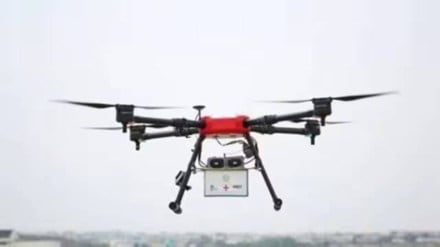In recent years, drones have emerged as a significant security threat to national borders, particularly in regions where tensions are high. With the rise in drone-related incidents along the borders with Pakistan and Bangladesh, the Indian government is taking proactive steps to counter this emerging menace. Home Minister Amit Shah recently announced the establishment of specialized anti-drone units to bolster the security of India’s borders, particularly in light of recent developments involving drones flown by neighbouring Bangladesh.
The Growing Drone Threat
The Indian government has long recognized the challenges posed by drones, particularly in areas like Punjab, where drones have been used for illegal activities such as weapon and drug smuggling. However, the situation has now escalated, especially along the Eastern Front, where tensions with Bangladesh have heightened. Recently, Bangladesh flew a Bayraktar TB2 combat drone, which has raised serious concerns in India due to its combat capabilities, including the ability to fire cruise missiles.
Home Minister Amit Shah, speaking at the 60th foundation day celebrations of the Border Security Force (BSF) in Jodhpur, Rajasthan, highlighted the growing scale of the drone problem. He warned that “this problem will become bigger in the coming days,” highlighting the need for coordinated efforts between various government agencies and security forces to tackle the evolving threat.
India’s Strategic Response
To address this, the Indian government is rolling out specialized anti-drone units, which will be equipped with advanced technology to detect and neutralize drones. The Ministry of Defence, along with the DRDO and other research agencies, have jointly developed a laser-equipped anti-drone gun mount system that will be deployed at key border areas. This technology will enhance India’s ability to intercept and destroy drones before they can carry out any malicious activities.
One of the significant challenges in combating drone threats is the difficulty in detecting small, fast-moving aerial targets. Traditional security systems, including radar, are often ill-equipped to handle the nuances of drone interception. The new anti-drone systems, however, promise to fill this gap, providing security forces with more effective tools to counter aerial threats. These units will be a critical addition to India’s border security infrastructure, which is already being bolstered by the Border Security Force (BSF), the first line of defence on the borders with Pakistan and Bangladesh.
The Impact of Drone Smuggling and Military Surveillance
The increasing use of drones along the borders has a dual impact. On one hand, drones are being used by adversarial forces for smuggling weapons, drugs, and other contraband across the borders. On the other hand, drones like the Bayraktar TB2 are being deployed for military reconnaissance and potentially even combat missions. The use of such drones by Bangladesh, which reportedly imported them from Turkey, adds a new layer of complexity to the security dynamics along the eastern border.
Bayraktar TB2
The Bayraktar TB2 is a High-Altitude Long Endurance (HALE) drone capable of carrying out precision strikes, making it a significant tool for military surveillance and combat. Its presence near the Indian border in West Bengal, where it was spotted earlier this month, has raised alarms. Although Bangladesh has not officially confirmed the use of these drones for border monitoring, the sighting of the Bayraktar TB2 has underscored the growing military capabilities of India’s neighbours and the need for a robust countermeasure.
The Bayraktar Threat: A Regional Concern
The Bayraktar TB2 drone has gained international notoriety for its effectiveness in the Ukraine war, where it was used to strike targets with precision. The fact that both Bangladesh and Pakistan have acquired these drones is a source of growing concern for India. Pakistan, which already uses Bayraktar drones along the Indian border near Lahore, has been integrating these advanced systems into its military operations, further escalating the strategic competition in the region.
The use of such advanced drones has prompted India to reevaluate its own aerial defense capabilities. While India currently operates drones like the Israeli-made Heron and Searcher for surveillance purposes, these are not combat drones like the Bayraktar TB2. To counter this gap, India is looking to enhance its drone fleet and develop more sophisticated counter-drone technologies.
The Role of the BSF
The BSF, which plays a crucial role in guarding India’s borders with Pakistan and Bangladesh, is already dealing with an increasing number of drone-related incidents. Over the past few years, the BSF has successfully intercepted and shot down several drones attempting to smuggle weapons and drugs from across the border. According to Home Minister Amit Shah, the BSF has managed to thwart 55% of drone attacks along the Punjab border, a significant improvement from just 3% in previous years. This progress is a testament to the effectiveness of the counter-drone systems currently in place, but the growing sophistication of drone threats means that more advanced solutions are necessary.
The BSF’s ability to adapt to the changing security landscape is crucial. As the largest border guarding force in the world, with a strength of over 270,000 personnel, the BSF’s role in securing India’s borders is indispensable. Over the past six decades, the force has evolved to tackle a range of challenges, from counterfeit currency and narcotics smuggling to insurgency and infiltration. As drone technology continues to evolve, the BSF’s capabilities will need to keep pace with these new threats.
